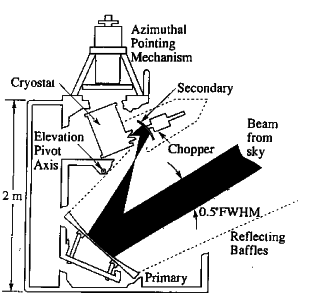Purpose of the flight and payload description
A gondola (UCSB's Advanced Cosmic Microwave Explorer (ACME) gondola) houses the MAX experiment including the telescope optics, a millimeter-wave receiver, and a system for pointing the telescope.
MAX rapidly compares two different points on the sky by mechanical modulation of the secondary mirror. Anisotropy in the CMB gives a measured "temperature difference" between these two points on the sky. MAX scans several sky regions in one night of observation. In sky regions that are free of galactic interference MAX measures anisotropy in the temperature of the 2.73 degree Kelvin CMB of roughly three parts in 100,000.
A four frequency band photometer allows discrimination of the CMB from galactic interference based on differences in spectra.
An Adiabatic Demagnetization Refrigerator (ADR) cools the bolometric detectors to below 100 mK, giving high sensitivity.
Details of the balloon flight
Balloon launched on: 6/16/1993 at 1:17 utc
Launch site: Columbia Scientific Balloon Facility, Palestine, Texas, US
Balloon launched by: National Scientific Balloon Facility (NSBF)
Balloon manufacturer/size/composition: Zero Pressure Balloon SF3-317.60-080-NSCH-02
Balloon serial number: W11.82-1-07
Flight identification number: 1527P
End of flight (L for landing time, W for last contact, otherwise termination time): 6/16/1993 at 12:28 utc
Balloon flight duration (F: time at float only, otherwise total flight time in d:days / h:hours or m:minutes - ): F 7 h
Landing site: 3 miles NW of Miles, Texas, US
External references
- MAX website at Berkeley University server (via Archive.Org)
- NASA Balloon Flights (1989-1998) in NASA Historical Data Book, Vol. VII: NASA Launch Systems, Space Transportation, Human Spaceflight, and Space Science, 1989-1998
- The Millimeter Wave Anisotropy Experiment (MAX) Astrophysical Letters and Communications, Vol. 32, p.223
1662If you consider this website interesting or useful, you can help me to keep it up and running with a small donation to cover the operational costs. Just the equivalent of the price of a cup of coffee helps a lot.


